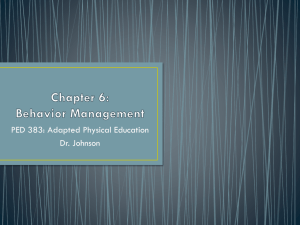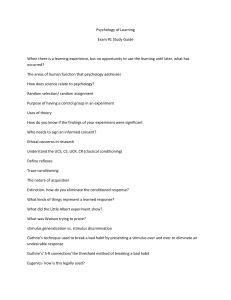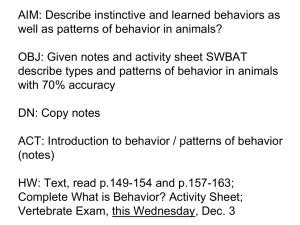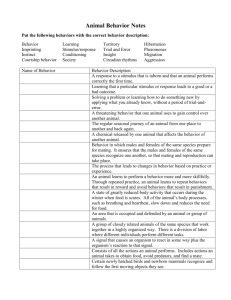Exercise Behavior Management
advertisement
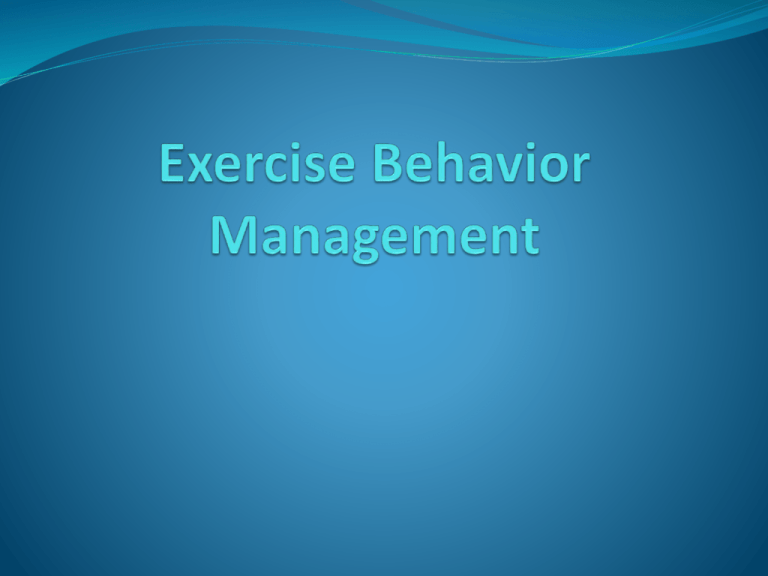
Too Many “Obligations” ? What is a behavior? Behaviors have dimensions that can be measured: A. Frequency —number of times a behavior occurs B. Duration —time from which a behavior begins until it ends C. Intensity—physical force involved in the behavior Frequency, Duration, and Intensity are all physical dimensions of behavior Behaviors can be: 1.observed 2.described 3.recorded Exercise and Sedentary Activities are behaviors….. Risk Behaviors Those that increase the susceptibility to negative health outcomes Sedentary behaviors are risk behaviors. The dimensions of risk behaviors can be modified Change duration of behavior Change the frequency of the behavior Change the “impact” (intensity) of the behavior Behavior Modification Focus is on the behavior. It is designed to change the behavior, not a characteristic or trait of the individual. Therefore, it de-emphasizes labeling The behavior to be changed is called the Target Behavior (Sedentary Lifestyle) Behavioral excess (Sedentary Activity) is an undesirable target behavior that needs to be decreased in frequency, duration, and intensity. Behavioral deficit (Physical Activity) is a desirable target behavior that is seeking to be increased in frequency, duration, and intensity Behavior Modification Emphasis is on current environmental events. Involves assessment and modification of the current environment that is functionally related to the behavior . What are the environmental events that promote sedentary behavior and devalue exercise behavior? Environmental Factors Once these controlling variables are identified they are altered to modify the behavior. Behavior Modification Predisposing Factors (what you already have) can influence behavior change: Knowledge Beliefs Values Attitudes Culture Accessibility to Health Information and Care Behavior Modification Enabling Factors (what can help you) can influence behavior change: Resources Skills (physical and mental) Time / Schedule Money Behavior Modification Reinforcing Factors (what champions the behavior)can influence behavior change: Incentive and Rewards Family Support Peer support Reinforcement (see next slide) Positive Negative Behavior Modification Reinforcement Definition: Reinforcement is a process in which a behavior is strengthened by the immediate consequence that reliably (consistently) follows it occurrence. It can be either positive or negative. In other words……When a behavior is strengthened it is more likely to occur in the future Behavior Modification Positive Reinforcement Definition: 1. The occurrence of a behavior 2. Is followed by the addition of a stimulus or increase in the intensity of a stimulus 3. Which strengthens the behavior Negative Reinforcement Definition: 1. The occurrence of a behavior 2. Is followed by the removal of a stimulus or decrease in the intensity of a stimulus 3. Which strengthens the behavior Behavior Modification Example of Positive Reinforcement (R+) Begin an exercise program After one week, loses two pounds Increases the frequency of exercise to lose more weight Example of Negative Reinforcement (R+) Stops exercising on a consistent schedule Begins gaining weight (looks and feels worse) Increases the frequency of exercise to lose more weight (ie. remove the weight gain) Behavior Modification In R+ the stimulus that is presented or appears following a behavior is called a positive reinforcer In R- the stimulus that is removed or avoided following a behavior is called an aversive stimulus Difference between R+ and R- is that in R+ a response produces a stimulus (positive reinforcer) Whereas, in R- a response removes or prevents the occurrence of a stimulus (aversive stimulus) In both cases, the behavior is likely to occur again in the future. Some confuse Negative Reinforcement with Punishment. They are not the same!!! Negative Reinforcement, like Positive Reinforcement increases or strengthens the behavior Punishment, in contrast and by definition, decreases or weakens a behavior Behavior Modification Key Points on Reinforcement…. Exercise must be a positive reinforcer (What are the positive benefits to exercise?) Exercise must remove the aversive stimulus (What benefits will you lose if you do not exercise?) Exercise should never be experienced as punishment Where to begin…Behavior Modification Analyzing Exercise Behavior Frequency Duration Seriousness Perceived seriousness Perceived susceptibility Cues to action Basis for problem behavior Antecedents Exercise Readiness (hyperlink) Stages of Behavior Change (hyperlink) End of Presentation

